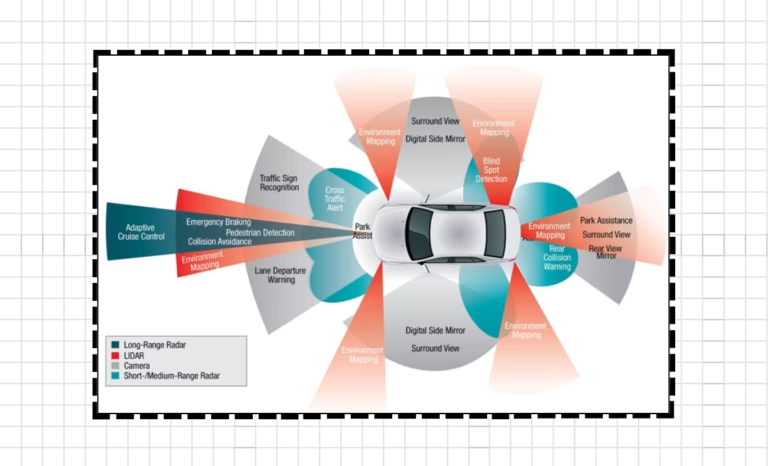
In busy Indian cities, where traffic is heavy and streets are narrow, drivers are always looking for ways to stay safe on the roads. Advanced Driver Assistance Systems (ADAS) have become a solution, changing road safety and making driving easier.
These modern technologies are designed to help drivers and improve their overall driving experience. As the Indian car industry adopts this innovation, ADAS is becoming an important feature in new vehicles.
From warnings when leaving the lane to automatic emergency braking, these systems aim to make driving safer, smarter, and more efficient for millions of people on the road.
In this article
Kutty Story
In a busy city in India, Rina, who commutes daily, was always worried about the heavy traffic and narrow streets. One rainy evening, while driving home, her car’s lane departure warning system beeped, alerting her that she had accidentally drifted out of her lane. Just in time, the automatic emergency braking activated, preventing a crash with a car that had stopped suddenly in front of her.
Rina had heard of ADAS (Advanced Driver Assistance Systems), but she never realized how important they were until that moment. These systems were not just new technology—they were life-saving tools made to protect drivers like her. As India’s roads improved, Rina saw that ADAS was no longer a luxury; it was becoming essential.
Despite challenges like infrastructure and awareness, the growth of ADAS technology in India signals the start of a safer and smarter future. As more people like Rina use these innovations and the country upgrades its roads and rules, India’s automotive world will become safer and more technology-driven.
Advanced Driver Assistance Systems (ADAS) are transforming the automotive industry in India. Enhancing the driving experience and safety for the passengers.
In 2025, the Indian ADAS market is projected to reach approximately USD 2.97 billion and will be expected to grow USD 6.89 billion by 2030, reflecting a compound annual growth rate (CAGR) of 18.33% during this period.
Understanding ADAS and it’s importance
ADAS is a collection of electronic systems designed to assist drivers in various ways, improving safety and convenience. The key features include:
- Lane Departure Warning: Alerts drivers when the vehicle drifts out of its lane, which helps to prevent accidents caused by unintentional lane departures.
- Adaptive Cruise Control: Automatically adjusts the vehicle’s speed to maintain a safe distance from the vehicle ahead, reducing driver fatigue and improving fuel efficiency on long trips.
- Automatic Emergency Braking: Uses the brakes automatically to avoid or mitigate a collision, particularly in emergency situations.
- Blind Spot Monitoring: Detects vehicles in the driver’s blind spots and sends alerts to improve situational awareness during lane changes.
- Parking Assistance: Helps drivers with parking maneuvers by providing guidance or automated control, making parking safer and more convenient.
These systems use sensors, cameras, and radar to monitor the vehicle’s surroundings, detect potential hazards, and provide timely alerts or interventions to help avoid accidents.
Adoption of ADAS is increasing in India as road safety awareness and demand for advanced vehicle features rise. According to a survey, 82% of Indian drivers are willing to invest in ADAS-equipped vehicles, primarily for the safety benefits they provide. [source]
Current Adoption and Future Projections
Advanced Driver Assistance Systems (ADAS) are gaining traction in India, driven by increasing consumer demand for enhanced safety features and the automotive industry’s commitment to innovation. A survey conducted in November 2024 revealed that 91% of Indian road users support ADAS, with 82% willing to purchase vehicles equipped with these systems. [source]
The Indian automotive market is projected to grow significantly, with expectations to reach 8 million units by the mid-2030s. [source]
This growth is anticipated to accelerate the adoption of ADAS technologies as consumers increasingly prioritize safety and technological advancements in their vehicle choices.
Challenges in ADAS Implementation in India
Despite the positive outlook, several challenges hinder the widespread adoption of ADAS in India:
- Road Infrastructure: Many Indian roads lack clear lane markings and traffic signs, which are essential for the proper functioning of ADAS features like lane-keeping assist and adaptive cruise control.
- Traffic Conditions: The presence of unmarked lanes, erratic driving behaviors, and unpredictable traffic patterns can confuse ADAS sensors, leading to misinterpretations and potential safety risks.
- Regulatory Framework: The complex regulatory environment in India may restrict the types of ADAS technologies that can be installed in vehicles, potentially delaying their integration into the market.
- Affordability: The cost of ADAS-equipped vehicles may be prohibitive for a significant portion of the Indian population, limiting the technology’s reach to higher-income consumers.
- Consumer Awareness: A lack of awareness and understanding of ADAS features among consumers can impede adoption rates, as potential buyers may be hesitant to invest in unfamiliar technologies.
Future Outlook
The Indian automotive industry is poised for a transformative shift toward a more sustainable and technology-driven future. Companies are focusing on expanding their product portfolios to include vehicles with advanced safety features, aligning with the evolving preferences of Indian consumers.
Besides ADAS, artificial intelligence (AI) is also helping to create the next generation of smart cars. AI is being added to cars to improve the driving experience, boost vehicle performance, and offer better safety features. To find out more about how AI is changing the car industry, read this article on AI in Cars.
To address the challenges, stakeholders are working collaboratively to enhance road infrastructure, standardize ADAS technologies, and educate consumers about the benefits of these systems. As these efforts progress, the adoption of ADAS in India is expected to increase, contributing to improved road safety and a more advanced automotive landscape.
Conclusion
Rina’s close call on a rainy evening shows how life-saving ADAS (Advanced Driver Assistance Systems) can be. As the technology improves and becomes more popular, it is changing how Indians think about road safety. Even though there are still challenges like limited infrastructure, cost, and lack of awareness, ADAS has a bright future in India.
As road conditions get better and more people learn about ADAS, it will help make India’s roads safer and its vehicles more advanced. The journey to smarter and safer driving has just started, and with more innovation and investment, ADAS will soon be available to everyone.





